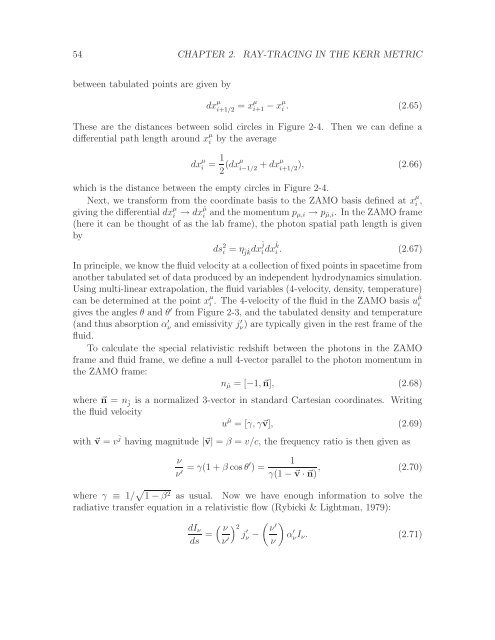Radiation Transport Around Kerr Black Holes Jeremy David ...
Radiation Transport Around Kerr Black Holes Jeremy David ...
Radiation Transport Around Kerr Black Holes Jeremy David ...
Create successful ePaper yourself
Turn your PDF publications into a flip-book with our unique Google optimized e-Paper software.
54 CHAPTER 2. RAY-TRACING IN THE KERR METRIC<br />
between tabulated points are given by<br />
dx µ i+1/2 = xµ i+1 − xµ i . (2.65)<br />
These are the distances between solid circles in Figure 2-4. Then we can define a<br />
differential path length around x µ i by the average<br />
dx µ i = 1 2 (dxµ i−1/2 + dxµ i+1/2<br />
), (2.66)<br />
which is the distance between the empty circles in Figure 2-4.<br />
Next, we transform from the coordinate basis to the ZAMO basis defined at x µ i ,<br />
giving the differential dx µ i → dxˆµ i and the momentum p µ,i → pˆµ,i . In the ZAMO frame<br />
(here it can be thought of as the lab frame), the photon spatial path length is given<br />
by<br />
ds 2 i = η ĵˆk dxĵdxˆk<br />
i i . (2.67)<br />
In principle, we know the fluid velocity at a collection of fixed points in spacetime from<br />
another tabulated set of data produced by an independent hydrodynamics simulation.<br />
Using multi-linear extrapolation, the fluid variables (4-velocity, density, temperature)<br />
can be determined at the point x µ i . The 4-velocity of the fluid in the ZAMO basis uˆµ i<br />
gives the angles θ and θ ′ from Figure 2-3, and the tabulated density and temperature<br />
(and thus absorption α ν ′ and emissivity j′ ν ) are typically given in the rest frame of the<br />
fluid.<br />
To calculate the special relativistic redshift between the photons in the ZAMO<br />
frame and fluid frame, we define a null 4-vector parallel to the photon momentum in<br />
the ZAMO frame:<br />
nˆµ = [−1,⃗n], (2.68)<br />
where ⃗n = nĵ is a normalized 3-vector in standard Cartesian coordinates. Writing<br />
the fluid velocity<br />
uˆµ = [γ, γ⃗v], (2.69)<br />
with ⃗v = vĵ having magnitude |⃗v| = β = v/c, the frequency ratio is then given as<br />
ν<br />
ν ′ = γ(1 + β cos θ ′ ) =<br />
1<br />
γ(1 − ⃗v · ⃗n) , (2.70)<br />
where γ ≡ 1/ √ 1 − β 2 as usual. Now we have enough information to solve the<br />
radiative transfer equation in a relativistic flow (Rybicki & Lightman, 1979):<br />
dI<br />
(<br />
ν ν<br />
) ( )<br />
2<br />
ds = j<br />
′ ν<br />
′<br />
ν ′ ν − α ν ′ ν<br />
I ν. (2.71)
















